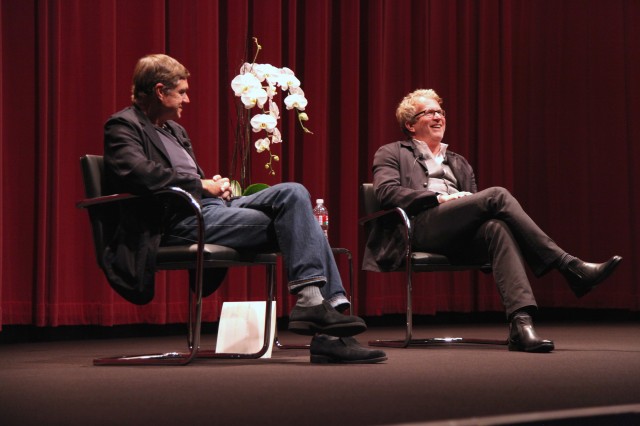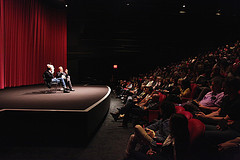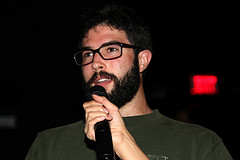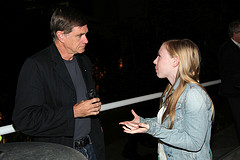
Filmmaker Gus Van Sant and architect Brad Cloepfil–two friends based in Portland, Oregon–spoke to a full house at the Hammer Museum’s Billy Wilder Auditorium about why they live in Portland, what influences their work, and how they get inspired. It was an entertaining and laid-back conversation occasioned by the publication of Allied Works Architecture/Brad Cloepfil: Occupation, a new book by Cloepfil and his firm.
Getting Away From it All
Van Sant opened the chat. “We’re here to talk about why we live in Portland and why we work there,” he explained.
“Why do we live in Portland?” asked Cloepfil.
For Van Sant, Portland is a place to escape the influences and distractions of Los Angeles. The smaller city is a “refuge,” he said, a place to hunker down and do your work while it rains.

“There’s a personality we share,” said Cloepfil. “We need the distance.” In big cities like Los Angeles and New York, “there’s a mirror reflecting back that some people thrive on–and some people [like us] flee to Portland, Oregon, and take solace in that place and that landscape.” Looking at buildings can be one type of influence. “But as far as the genesis, the spiritual inspiration for the work, for me it has to do with the [natural] landscape,” he said.
Van Sant recalled how he started his career in Los Angeles, moved to New York City, and after nearly a decade returned to Portland to make his breakout film, Mala Noche. Cloepfil, too, started working in L.A.–“living downtown, going to Al’s bar”–before heading east to New York and then ultimately to the Northwest to start his career with the 1998 Maryhill Overlook project.
Artistic Goals and Inspirations
For Cloepfil, a building is “an amplifier or lens” that reveals insights about place. His goal is for people to “see things that they wouldn’t have seen without the architecture.” In the new Clyfford Still Museum, which will open in November in Denver, Allied Works built a small building next to a bigger one in order to create a different urban context. “By building buildings you’re adding to the physical environment, and yet the goal I think for me is not to expand the conversation but almost to limit the conversation,” he said–to use buildings to bracket the rest of the world around us. A piece of architecture or a place can “filter the noise” out.
Where, Van Sant asked Cloepfil, does your precise moment of inspiration come from? Can it be as simple as looking at “a stack of sugar cubes on the table”?
Cloepfil laughed. “That’s Gus’s idea of architecture,” he said. But he added that, for him, inspiration can come out of anything from a mark on a paper to a piece of art–anything “that manifest[s] a quality you associate with one of the projects you’re working on.”

Van Sant was more specific about his own inspirations. “For me it’s a character, and you see one character in a place,” he said. “I usually see them in passing, it’s just a moment,” but from there he can go on to create a fully formed story and a screenplay.
“How do you determine the projects you do?” asked Cloepfil.
Van Sant explained that a number of his films are based on major news stories. Elephant was based on the Columbine Massacre, while Last Days was based on the final days before Kurt Cobain’s death. He likened these to dioramas that display “an unknown factor, like a mystery, something that can’t be known.”
Losing Control
At this stage of his career, said Cloepfil, “I’m learning where the limits of control get you, and even ways to try to at least intentionally let things have their own life.” For example, construction of the Still Museum involved working with concrete that was cast on-site. There was no way to know exactly how the end result would appear. This was a new experience for Cloepfil, one he didn’t think he could have had just a few years ago.
Cloepfil asked Van Sant about why he is consistently drawn to alienation and marginalization in the stories he tells.
It’s “a way to get away from the ordinary,” replied Van Sant. It’s not that alienation is an obsession per se; it’s that alienation offers a way of finding another place to tell a story. Another filmmaker might go to the Wild West.

“You set up contexts for people to see things they haven’t seen before,” said Cloepfil.
“And you do that” too, added Van Sant.
The Secret to Success? Keep Expectations Low
In a wide-ranging question and answer session, Cloepfil and Van Sant talked about the more practical aspects of their work: who funds it and how.
“The nice thing about architecture is that no one expects it to make money,” said Cloepfil. However, there are other pressures: during the construction of New York City’s Museum of Arts and Design, a donor changed a window during construction without consulting with Cloepfil’s firm.
Similar things happen in filmmaking, of course. Calling films “the worst investment ever,” Van Sant said that his strategy with investors is to ask for less money than they’re planning to give. That way they don’t expect to get anything back.
“Keep expectations low!” joked Cloepfil.
Watch full video here.
See more photos.
Watch a slideshow of art and photographs from Allied Works Architecture/Brad Cloepfil: Occupation here.
Buy the book: Skylight Books, Powell’s, Amazon.
Read artists’ opinions on how nature informs their work here.
*Photos by Aaron Salcido.




Send A Letter To the Editors